University Corporate Financial Management: Capital Budgeting Report
VerifiedAdded on 2022/11/22
|11
|2779
|68
Report
AI Summary
This report delves into the critical aspects of corporate financial management, specifically focusing on capital budgeting. It begins by defining capital budgeting and its significance in long-term investment decisions, such as machinery replacement and new product development. The report highlights the importance of evaluating potential expenditures and the challenges organizations face in selecting between various projects due to capital limitations. It then explores several capital budgeting techniques, including sensitivity analysis, scenario analysis, and break-even analysis, explaining their roles in assessing project viability and risk. The report also discusses the issues and problems associated with capital budgeting techniques, such as the uncertainty of future estimations and the subjectivity of risk assessment. It emphasizes the need for modern techniques and continuous refinement to minimize risks and improve decision-making accuracy in capital budgeting. The report concludes with recommendations for enhancing capital budgeting processes, including the use of advanced techniques to make more reliable estimations and increase company value.
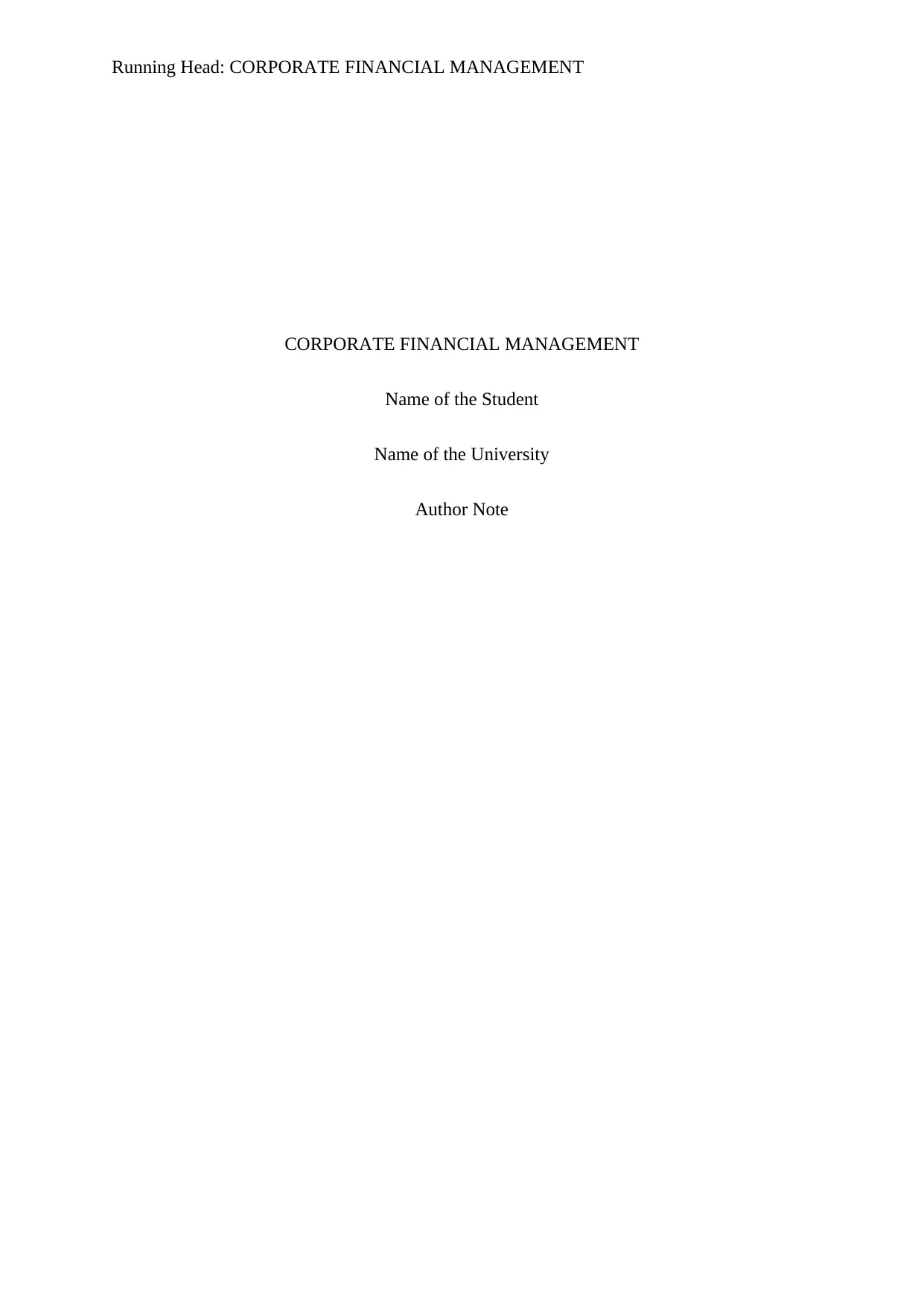
Running Head: CORPORATE FINANCIAL MANAGEMENT
CORPORATE FINANCIAL MANAGEMENT
Name of the Student
Name of the University
Author Note
CORPORATE FINANCIAL MANAGEMENT
Name of the Student
Name of the University
Author Note
Paraphrase This Document
Need a fresh take? Get an instant paraphrase of this document with our AI Paraphraser
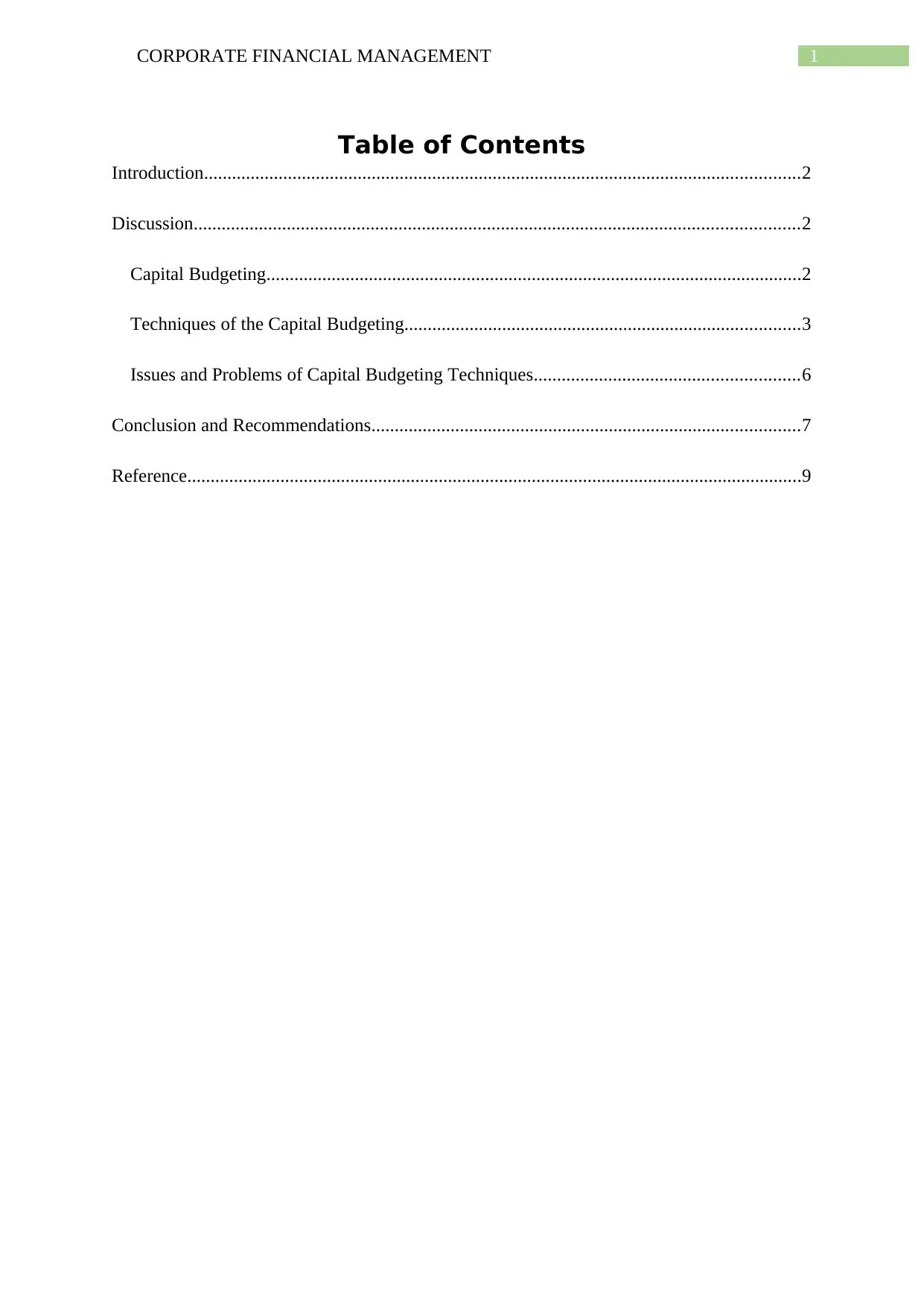
1CORPORATE FINANCIAL MANAGEMENT
Table of Contents
Introduction................................................................................................................................2
Discussion..................................................................................................................................2
Capital Budgeting...................................................................................................................2
Techniques of the Capital Budgeting.....................................................................................3
Issues and Problems of Capital Budgeting Techniques.........................................................6
Conclusion and Recommendations............................................................................................7
Reference....................................................................................................................................9
Table of Contents
Introduction................................................................................................................................2
Discussion..................................................................................................................................2
Capital Budgeting...................................................................................................................2
Techniques of the Capital Budgeting.....................................................................................3
Issues and Problems of Capital Budgeting Techniques.........................................................6
Conclusion and Recommendations............................................................................................7
Reference....................................................................................................................................9

2CORPORATE FINANCIAL MANAGEMENT
Introduction
The budgeting of Capital or the appraisal of investment is referred as the process of
the planning that is used for determining whether the investments of long-term of the firm
such as replacement of the machinery, projects of research development, new machinery as
well as new products are worth for funding of cash by structure of the capitalization of
company. It is the formal process of the company that is used by the company for the
evaluation of the potential expenditure or the investments, which are significant in the
amount. It is the method, which involves current funds for the disposition, addition,
replacement or modification of the fixed assets (Rossi 2014).
However, unfortunately, precision of the theory has been increased that has tended
towards obscuring certain basic issues and problems, which are involved in the decisions of
the capital budgeting. These obscuring factors includes lack of the satisfactory that means
estimation of the relative degrees of the uncertainty of the benefits, circularity of the
reasoning in the estimation of the costs of the capital as well as failure for recognizing the
expectations as well as risks that is perceived by the internal management are same as of the
investors. Therefore, in this assignment, analysis will be on the sensitivity, break-even
analysis, scenario analysis in the making of capital decisions. Moreover, discussion will also
be done on the issues and the problems that are relating to the techniques of capital
budgeting.
Discussion
Capital Budgeting
The term of capital budgeting is made up of the two words that is capital and the
budgeting. The capital budgeting, in this context is the defined as spending of the funds for
the large expenditures such as expansion, purchasing of the fixed assets and the equipment,
Introduction
The budgeting of Capital or the appraisal of investment is referred as the process of
the planning that is used for determining whether the investments of long-term of the firm
such as replacement of the machinery, projects of research development, new machinery as
well as new products are worth for funding of cash by structure of the capitalization of
company. It is the formal process of the company that is used by the company for the
evaluation of the potential expenditure or the investments, which are significant in the
amount. It is the method, which involves current funds for the disposition, addition,
replacement or modification of the fixed assets (Rossi 2014).
However, unfortunately, precision of the theory has been increased that has tended
towards obscuring certain basic issues and problems, which are involved in the decisions of
the capital budgeting. These obscuring factors includes lack of the satisfactory that means
estimation of the relative degrees of the uncertainty of the benefits, circularity of the
reasoning in the estimation of the costs of the capital as well as failure for recognizing the
expectations as well as risks that is perceived by the internal management are same as of the
investors. Therefore, in this assignment, analysis will be on the sensitivity, break-even
analysis, scenario analysis in the making of capital decisions. Moreover, discussion will also
be done on the issues and the problems that are relating to the techniques of capital
budgeting.
Discussion
Capital Budgeting
The term of capital budgeting is made up of the two words that is capital and the
budgeting. The capital budgeting, in this context is the defined as spending of the funds for
the large expenditures such as expansion, purchasing of the fixed assets and the equipment,
⊘ This is a preview!⊘
Do you want full access?
Subscribe today to unlock all pages.

Trusted by 1+ million students worldwide
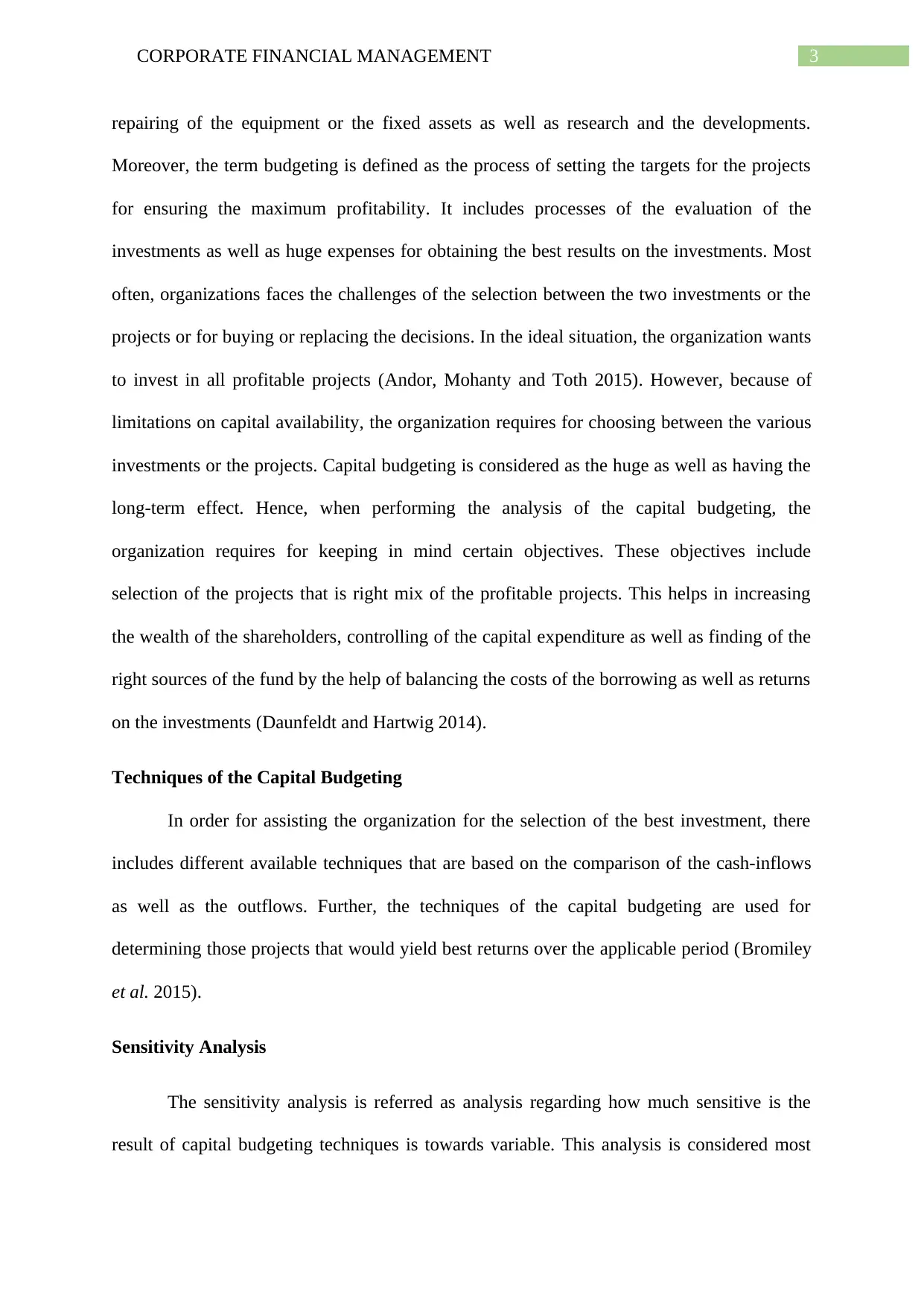
3CORPORATE FINANCIAL MANAGEMENT
repairing of the equipment or the fixed assets as well as research and the developments.
Moreover, the term budgeting is defined as the process of setting the targets for the projects
for ensuring the maximum profitability. It includes processes of the evaluation of the
investments as well as huge expenses for obtaining the best results on the investments. Most
often, organizations faces the challenges of the selection between the two investments or the
projects or for buying or replacing the decisions. In the ideal situation, the organization wants
to invest in all profitable projects (Andor, Mohanty and Toth 2015). However, because of
limitations on capital availability, the organization requires for choosing between the various
investments or the projects. Capital budgeting is considered as the huge as well as having the
long-term effect. Hence, when performing the analysis of the capital budgeting, the
organization requires for keeping in mind certain objectives. These objectives include
selection of the projects that is right mix of the profitable projects. This helps in increasing
the wealth of the shareholders, controlling of the capital expenditure as well as finding of the
right sources of the fund by the help of balancing the costs of the borrowing as well as returns
on the investments (Daunfeldt and Hartwig 2014).
Techniques of the Capital Budgeting
In order for assisting the organization for the selection of the best investment, there
includes different available techniques that are based on the comparison of the cash-inflows
as well as the outflows. Further, the techniques of the capital budgeting are used for
determining those projects that would yield best returns over the applicable period (Bromiley
et al. 2015).
Sensitivity Analysis
The sensitivity analysis is referred as analysis regarding how much sensitive is the
result of capital budgeting techniques is towards variable. This analysis is considered most
repairing of the equipment or the fixed assets as well as research and the developments.
Moreover, the term budgeting is defined as the process of setting the targets for the projects
for ensuring the maximum profitability. It includes processes of the evaluation of the
investments as well as huge expenses for obtaining the best results on the investments. Most
often, organizations faces the challenges of the selection between the two investments or the
projects or for buying or replacing the decisions. In the ideal situation, the organization wants
to invest in all profitable projects (Andor, Mohanty and Toth 2015). However, because of
limitations on capital availability, the organization requires for choosing between the various
investments or the projects. Capital budgeting is considered as the huge as well as having the
long-term effect. Hence, when performing the analysis of the capital budgeting, the
organization requires for keeping in mind certain objectives. These objectives include
selection of the projects that is right mix of the profitable projects. This helps in increasing
the wealth of the shareholders, controlling of the capital expenditure as well as finding of the
right sources of the fund by the help of balancing the costs of the borrowing as well as returns
on the investments (Daunfeldt and Hartwig 2014).
Techniques of the Capital Budgeting
In order for assisting the organization for the selection of the best investment, there
includes different available techniques that are based on the comparison of the cash-inflows
as well as the outflows. Further, the techniques of the capital budgeting are used for
determining those projects that would yield best returns over the applicable period (Bromiley
et al. 2015).
Sensitivity Analysis
The sensitivity analysis is referred as analysis regarding how much sensitive is the
result of capital budgeting techniques is towards variable. This analysis is considered most
Paraphrase This Document
Need a fresh take? Get an instant paraphrase of this document with our AI Paraphraser
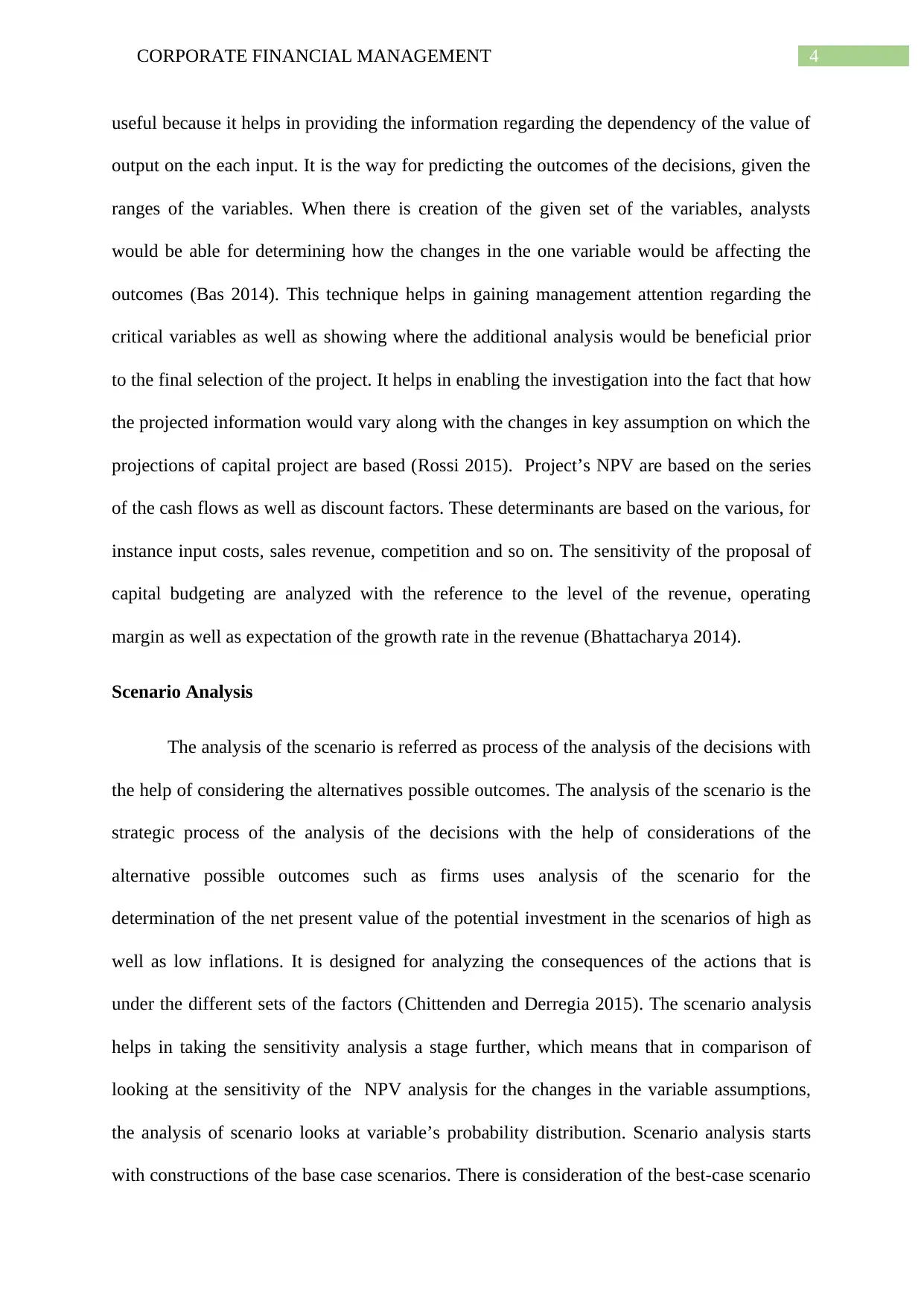
4CORPORATE FINANCIAL MANAGEMENT
useful because it helps in providing the information regarding the dependency of the value of
output on the each input. It is the way for predicting the outcomes of the decisions, given the
ranges of the variables. When there is creation of the given set of the variables, analysts
would be able for determining how the changes in the one variable would be affecting the
outcomes (Bas 2014). This technique helps in gaining management attention regarding the
critical variables as well as showing where the additional analysis would be beneficial prior
to the final selection of the project. It helps in enabling the investigation into the fact that how
the projected information would vary along with the changes in key assumption on which the
projections of capital project are based (Rossi 2015). Project’s NPV are based on the series
of the cash flows as well as discount factors. These determinants are based on the various, for
instance input costs, sales revenue, competition and so on. The sensitivity of the proposal of
capital budgeting are analyzed with the reference to the level of the revenue, operating
margin as well as expectation of the growth rate in the revenue (Bhattacharya 2014).
Scenario Analysis
The analysis of the scenario is referred as process of the analysis of the decisions with
the help of considering the alternatives possible outcomes. The analysis of the scenario is the
strategic process of the analysis of the decisions with the help of considerations of the
alternative possible outcomes such as firms uses analysis of the scenario for the
determination of the net present value of the potential investment in the scenarios of high as
well as low inflations. It is designed for analyzing the consequences of the actions that is
under the different sets of the factors (Chittenden and Derregia 2015). The scenario analysis
helps in taking the sensitivity analysis a stage further, which means that in comparison of
looking at the sensitivity of the NPV analysis for the changes in the variable assumptions,
the analysis of scenario looks at variable’s probability distribution. Scenario analysis starts
with constructions of the base case scenarios. There is consideration of the best-case scenario
useful because it helps in providing the information regarding the dependency of the value of
output on the each input. It is the way for predicting the outcomes of the decisions, given the
ranges of the variables. When there is creation of the given set of the variables, analysts
would be able for determining how the changes in the one variable would be affecting the
outcomes (Bas 2014). This technique helps in gaining management attention regarding the
critical variables as well as showing where the additional analysis would be beneficial prior
to the final selection of the project. It helps in enabling the investigation into the fact that how
the projected information would vary along with the changes in key assumption on which the
projections of capital project are based (Rossi 2015). Project’s NPV are based on the series
of the cash flows as well as discount factors. These determinants are based on the various, for
instance input costs, sales revenue, competition and so on. The sensitivity of the proposal of
capital budgeting are analyzed with the reference to the level of the revenue, operating
margin as well as expectation of the growth rate in the revenue (Bhattacharya 2014).
Scenario Analysis
The analysis of the scenario is referred as process of the analysis of the decisions with
the help of considering the alternatives possible outcomes. The analysis of the scenario is the
strategic process of the analysis of the decisions with the help of considerations of the
alternative possible outcomes such as firms uses analysis of the scenario for the
determination of the net present value of the potential investment in the scenarios of high as
well as low inflations. It is designed for analyzing the consequences of the actions that is
under the different sets of the factors (Chittenden and Derregia 2015). The scenario analysis
helps in taking the sensitivity analysis a stage further, which means that in comparison of
looking at the sensitivity of the NPV analysis for the changes in the variable assumptions,
the analysis of scenario looks at variable’s probability distribution. Scenario analysis starts
with constructions of the base case scenarios. There is consideration of the best-case scenario
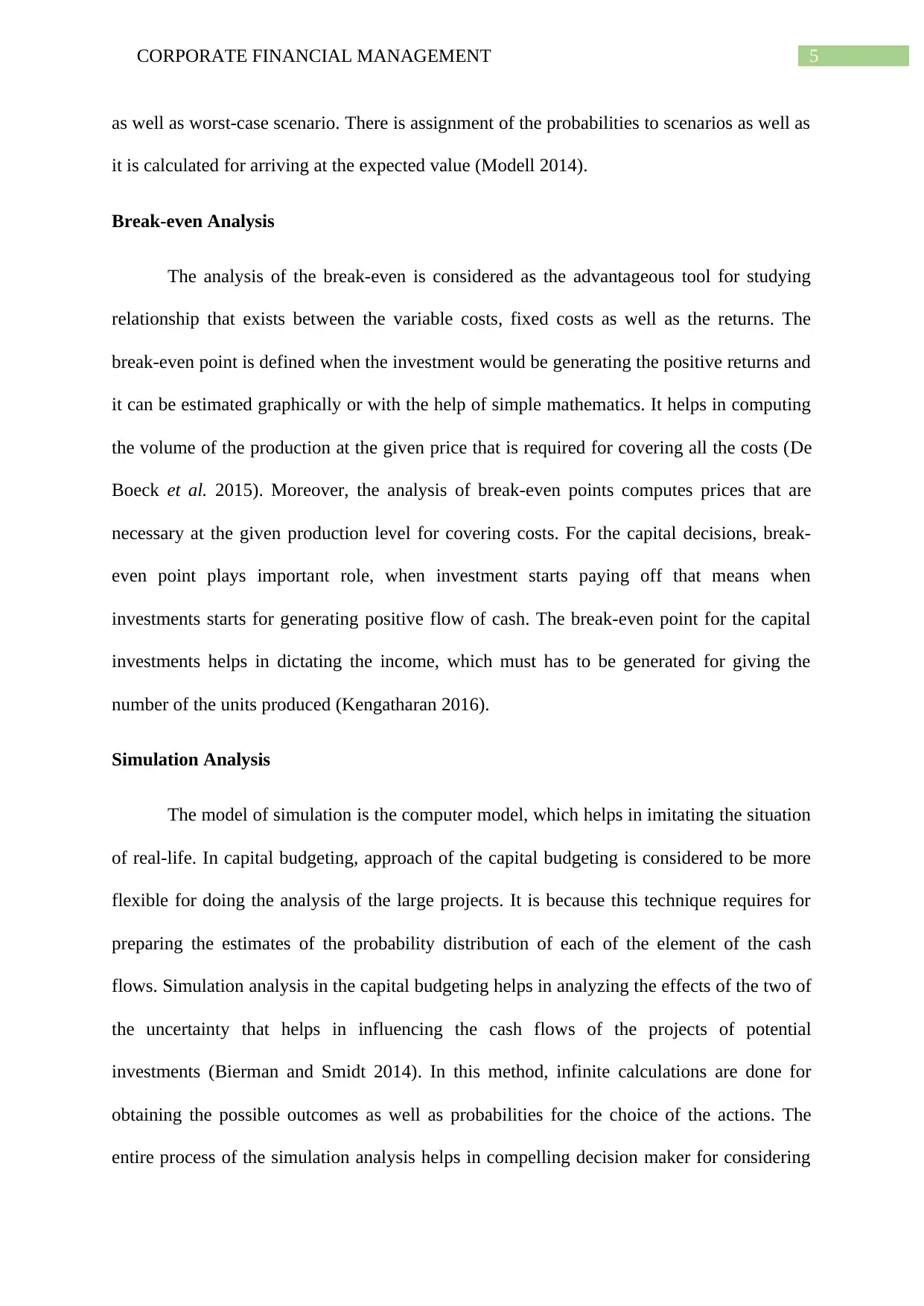
5CORPORATE FINANCIAL MANAGEMENT
as well as worst-case scenario. There is assignment of the probabilities to scenarios as well as
it is calculated for arriving at the expected value (Modell 2014).
Break-even Analysis
The analysis of the break-even is considered as the advantageous tool for studying
relationship that exists between the variable costs, fixed costs as well as the returns. The
break-even point is defined when the investment would be generating the positive returns and
it can be estimated graphically or with the help of simple mathematics. It helps in computing
the volume of the production at the given price that is required for covering all the costs (De
Boeck et al. 2015). Moreover, the analysis of break-even points computes prices that are
necessary at the given production level for covering costs. For the capital decisions, break-
even point plays important role, when investment starts paying off that means when
investments starts for generating positive flow of cash. The break-even point for the capital
investments helps in dictating the income, which must has to be generated for giving the
number of the units produced (Kengatharan 2016).
Simulation Analysis
The model of simulation is the computer model, which helps in imitating the situation
of real-life. In capital budgeting, approach of the capital budgeting is considered to be more
flexible for doing the analysis of the large projects. It is because this technique requires for
preparing the estimates of the probability distribution of each of the element of the cash
flows. Simulation analysis in the capital budgeting helps in analyzing the effects of the two of
the uncertainty that helps in influencing the cash flows of the projects of potential
investments (Bierman and Smidt 2014). In this method, infinite calculations are done for
obtaining the possible outcomes as well as probabilities for the choice of the actions. The
entire process of the simulation analysis helps in compelling decision maker for considering
as well as worst-case scenario. There is assignment of the probabilities to scenarios as well as
it is calculated for arriving at the expected value (Modell 2014).
Break-even Analysis
The analysis of the break-even is considered as the advantageous tool for studying
relationship that exists between the variable costs, fixed costs as well as the returns. The
break-even point is defined when the investment would be generating the positive returns and
it can be estimated graphically or with the help of simple mathematics. It helps in computing
the volume of the production at the given price that is required for covering all the costs (De
Boeck et al. 2015). Moreover, the analysis of break-even points computes prices that are
necessary at the given production level for covering costs. For the capital decisions, break-
even point plays important role, when investment starts paying off that means when
investments starts for generating positive flow of cash. The break-even point for the capital
investments helps in dictating the income, which must has to be generated for giving the
number of the units produced (Kengatharan 2016).
Simulation Analysis
The model of simulation is the computer model, which helps in imitating the situation
of real-life. In capital budgeting, approach of the capital budgeting is considered to be more
flexible for doing the analysis of the large projects. It is because this technique requires for
preparing the estimates of the probability distribution of each of the element of the cash
flows. Simulation analysis in the capital budgeting helps in analyzing the effects of the two of
the uncertainty that helps in influencing the cash flows of the projects of potential
investments (Bierman and Smidt 2014). In this method, infinite calculations are done for
obtaining the possible outcomes as well as probabilities for the choice of the actions. The
entire process of the simulation analysis helps in compelling decision maker for considering
⊘ This is a preview!⊘
Do you want full access?
Subscribe today to unlock all pages.

Trusted by 1+ million students worldwide
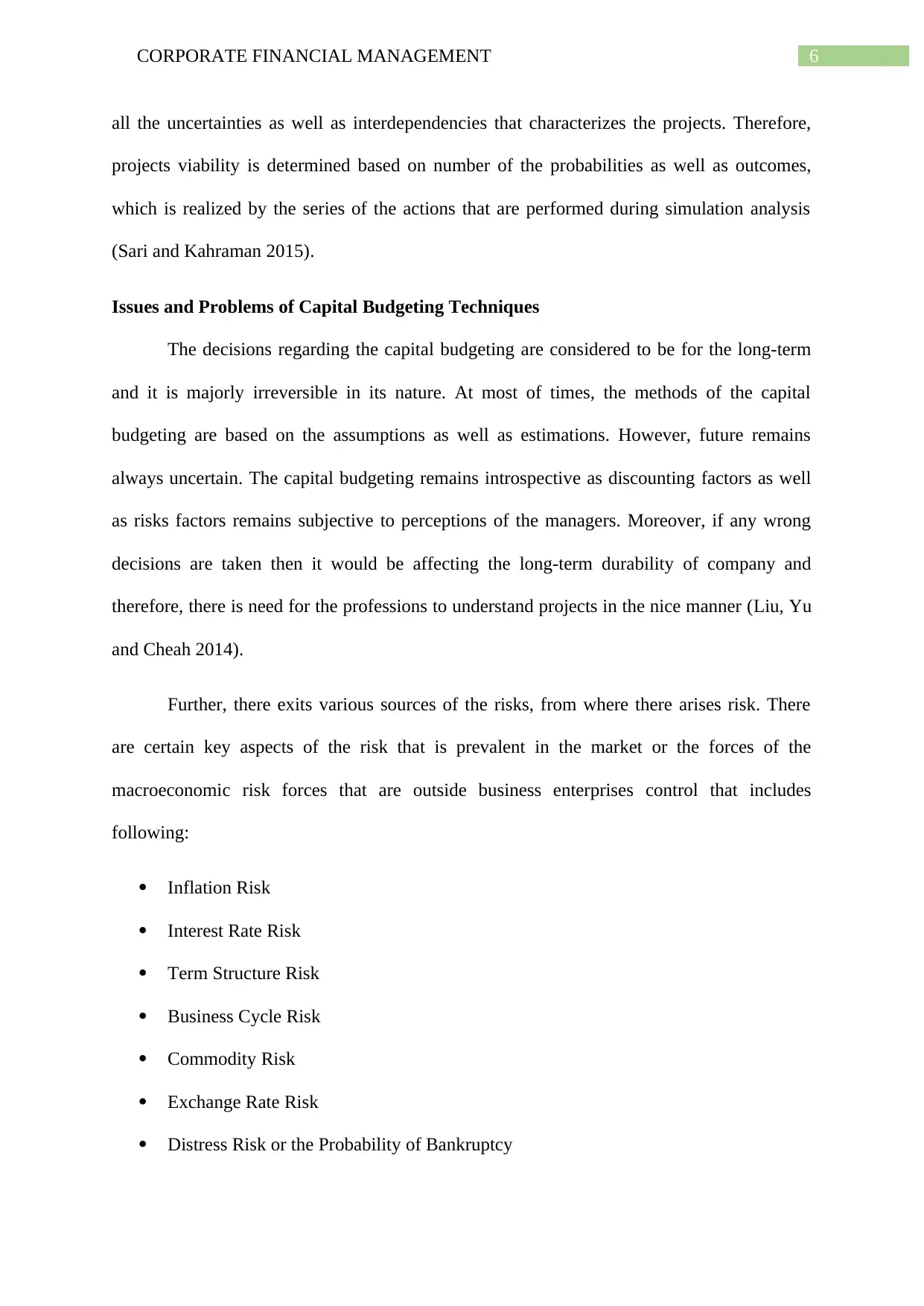
6CORPORATE FINANCIAL MANAGEMENT
all the uncertainties as well as interdependencies that characterizes the projects. Therefore,
projects viability is determined based on number of the probabilities as well as outcomes,
which is realized by the series of the actions that are performed during simulation analysis
(Sari and Kahraman 2015).
Issues and Problems of Capital Budgeting Techniques
The decisions regarding the capital budgeting are considered to be for the long-term
and it is majorly irreversible in its nature. At most of times, the methods of the capital
budgeting are based on the assumptions as well as estimations. However, future remains
always uncertain. The capital budgeting remains introspective as discounting factors as well
as risks factors remains subjective to perceptions of the managers. Moreover, if any wrong
decisions are taken then it would be affecting the long-term durability of company and
therefore, there is need for the professions to understand projects in the nice manner (Liu, Yu
and Cheah 2014).
Further, there exits various sources of the risks, from where there arises risk. There
are certain key aspects of the risk that is prevalent in the market or the forces of the
macroeconomic risk forces that are outside business enterprises control that includes
following:
Inflation Risk
Interest Rate Risk
Term Structure Risk
Business Cycle Risk
Commodity Risk
Exchange Rate Risk
Distress Risk or the Probability of Bankruptcy
all the uncertainties as well as interdependencies that characterizes the projects. Therefore,
projects viability is determined based on number of the probabilities as well as outcomes,
which is realized by the series of the actions that are performed during simulation analysis
(Sari and Kahraman 2015).
Issues and Problems of Capital Budgeting Techniques
The decisions regarding the capital budgeting are considered to be for the long-term
and it is majorly irreversible in its nature. At most of times, the methods of the capital
budgeting are based on the assumptions as well as estimations. However, future remains
always uncertain. The capital budgeting remains introspective as discounting factors as well
as risks factors remains subjective to perceptions of the managers. Moreover, if any wrong
decisions are taken then it would be affecting the long-term durability of company and
therefore, there is need for the professions to understand projects in the nice manner (Liu, Yu
and Cheah 2014).
Further, there exits various sources of the risks, from where there arises risk. There
are certain key aspects of the risk that is prevalent in the market or the forces of the
macroeconomic risk forces that are outside business enterprises control that includes
following:
Inflation Risk
Interest Rate Risk
Term Structure Risk
Business Cycle Risk
Commodity Risk
Exchange Rate Risk
Distress Risk or the Probability of Bankruptcy
Paraphrase This Document
Need a fresh take? Get an instant paraphrase of this document with our AI Paraphraser
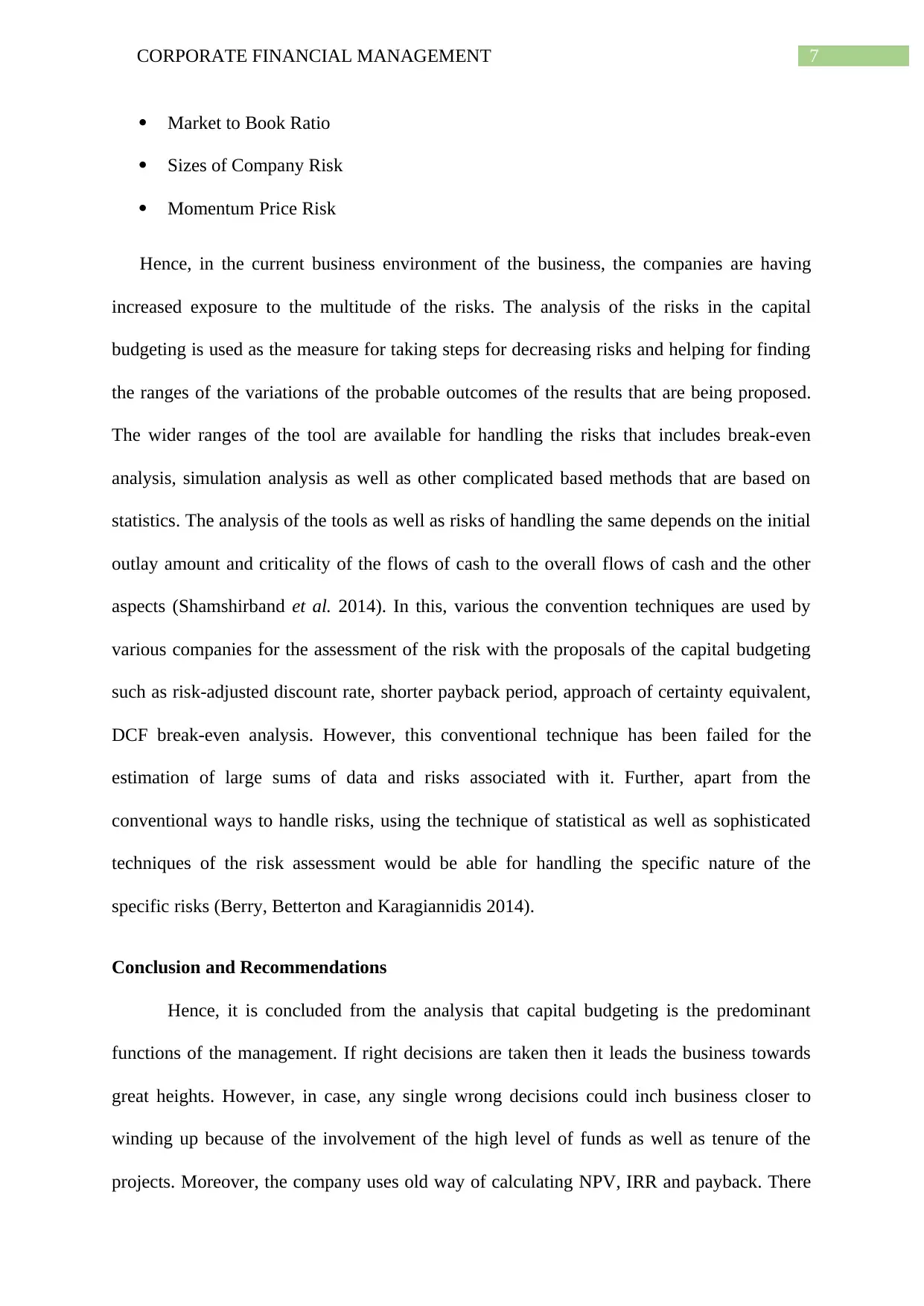
7CORPORATE FINANCIAL MANAGEMENT
Market to Book Ratio
Sizes of Company Risk
Momentum Price Risk
Hence, in the current business environment of the business, the companies are having
increased exposure to the multitude of the risks. The analysis of the risks in the capital
budgeting is used as the measure for taking steps for decreasing risks and helping for finding
the ranges of the variations of the probable outcomes of the results that are being proposed.
The wider ranges of the tool are available for handling the risks that includes break-even
analysis, simulation analysis as well as other complicated based methods that are based on
statistics. The analysis of the tools as well as risks of handling the same depends on the initial
outlay amount and criticality of the flows of cash to the overall flows of cash and the other
aspects (Shamshirband et al. 2014). In this, various the convention techniques are used by
various companies for the assessment of the risk with the proposals of the capital budgeting
such as risk-adjusted discount rate, shorter payback period, approach of certainty equivalent,
DCF break-even analysis. However, this conventional technique has been failed for the
estimation of large sums of data and risks associated with it. Further, apart from the
conventional ways to handle risks, using the technique of statistical as well as sophisticated
techniques of the risk assessment would be able for handling the specific nature of the
specific risks (Berry, Betterton and Karagiannidis 2014).
Conclusion and Recommendations
Hence, it is concluded from the analysis that capital budgeting is the predominant
functions of the management. If right decisions are taken then it leads the business towards
great heights. However, in case, any single wrong decisions could inch business closer to
winding up because of the involvement of the high level of funds as well as tenure of the
projects. Moreover, the company uses old way of calculating NPV, IRR and payback. There
Market to Book Ratio
Sizes of Company Risk
Momentum Price Risk
Hence, in the current business environment of the business, the companies are having
increased exposure to the multitude of the risks. The analysis of the risks in the capital
budgeting is used as the measure for taking steps for decreasing risks and helping for finding
the ranges of the variations of the probable outcomes of the results that are being proposed.
The wider ranges of the tool are available for handling the risks that includes break-even
analysis, simulation analysis as well as other complicated based methods that are based on
statistics. The analysis of the tools as well as risks of handling the same depends on the initial
outlay amount and criticality of the flows of cash to the overall flows of cash and the other
aspects (Shamshirband et al. 2014). In this, various the convention techniques are used by
various companies for the assessment of the risk with the proposals of the capital budgeting
such as risk-adjusted discount rate, shorter payback period, approach of certainty equivalent,
DCF break-even analysis. However, this conventional technique has been failed for the
estimation of large sums of data and risks associated with it. Further, apart from the
conventional ways to handle risks, using the technique of statistical as well as sophisticated
techniques of the risk assessment would be able for handling the specific nature of the
specific risks (Berry, Betterton and Karagiannidis 2014).
Conclusion and Recommendations
Hence, it is concluded from the analysis that capital budgeting is the predominant
functions of the management. If right decisions are taken then it leads the business towards
great heights. However, in case, any single wrong decisions could inch business closer to
winding up because of the involvement of the high level of funds as well as tenure of the
projects. Moreover, the company uses old way of calculating NPV, IRR and payback. There
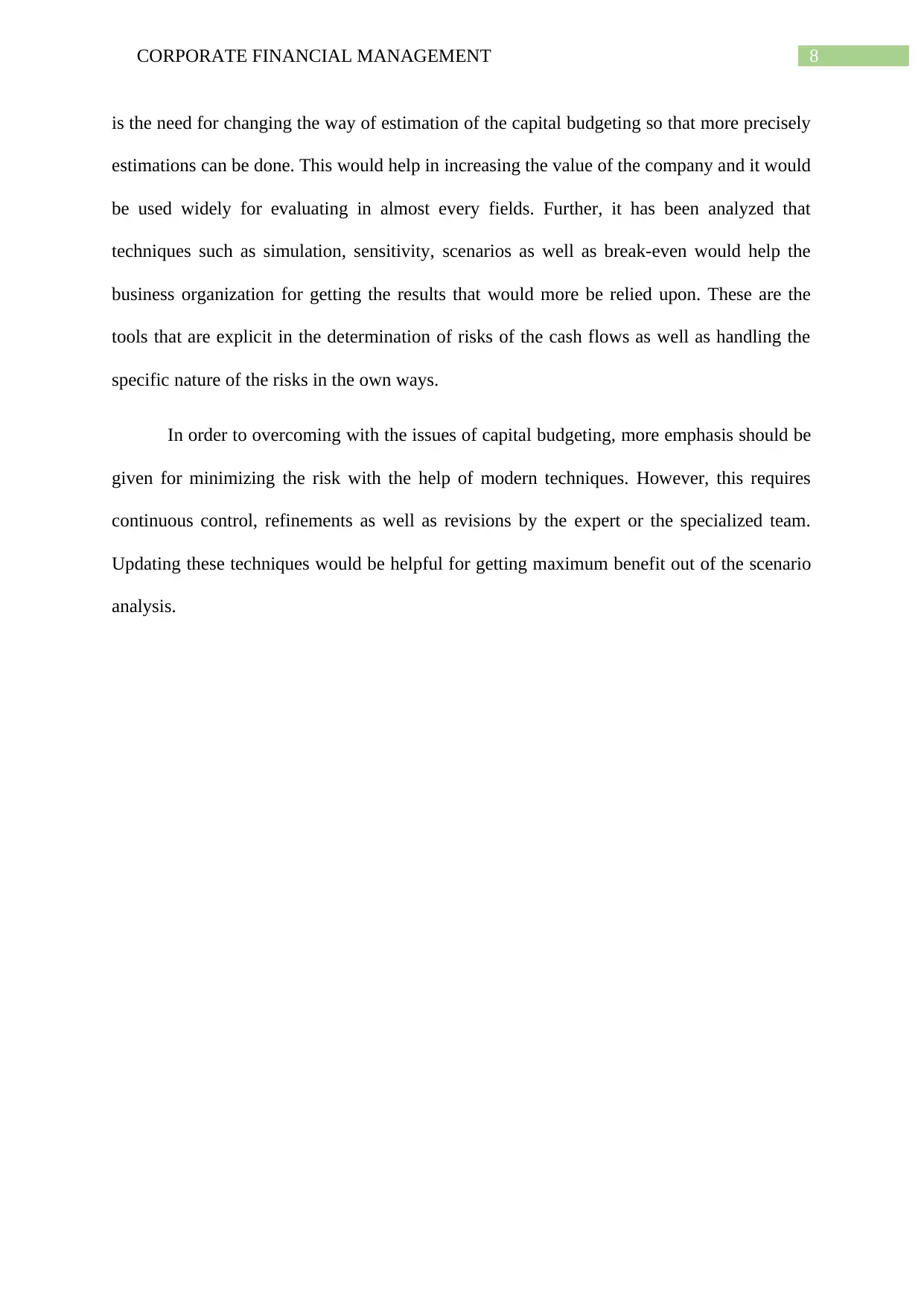
8CORPORATE FINANCIAL MANAGEMENT
is the need for changing the way of estimation of the capital budgeting so that more precisely
estimations can be done. This would help in increasing the value of the company and it would
be used widely for evaluating in almost every fields. Further, it has been analyzed that
techniques such as simulation, sensitivity, scenarios as well as break-even would help the
business organization for getting the results that would more be relied upon. These are the
tools that are explicit in the determination of risks of the cash flows as well as handling the
specific nature of the risks in the own ways.
In order to overcoming with the issues of capital budgeting, more emphasis should be
given for minimizing the risk with the help of modern techniques. However, this requires
continuous control, refinements as well as revisions by the expert or the specialized team.
Updating these techniques would be helpful for getting maximum benefit out of the scenario
analysis.
is the need for changing the way of estimation of the capital budgeting so that more precisely
estimations can be done. This would help in increasing the value of the company and it would
be used widely for evaluating in almost every fields. Further, it has been analyzed that
techniques such as simulation, sensitivity, scenarios as well as break-even would help the
business organization for getting the results that would more be relied upon. These are the
tools that are explicit in the determination of risks of the cash flows as well as handling the
specific nature of the risks in the own ways.
In order to overcoming with the issues of capital budgeting, more emphasis should be
given for minimizing the risk with the help of modern techniques. However, this requires
continuous control, refinements as well as revisions by the expert or the specialized team.
Updating these techniques would be helpful for getting maximum benefit out of the scenario
analysis.
⊘ This is a preview!⊘
Do you want full access?
Subscribe today to unlock all pages.

Trusted by 1+ million students worldwide
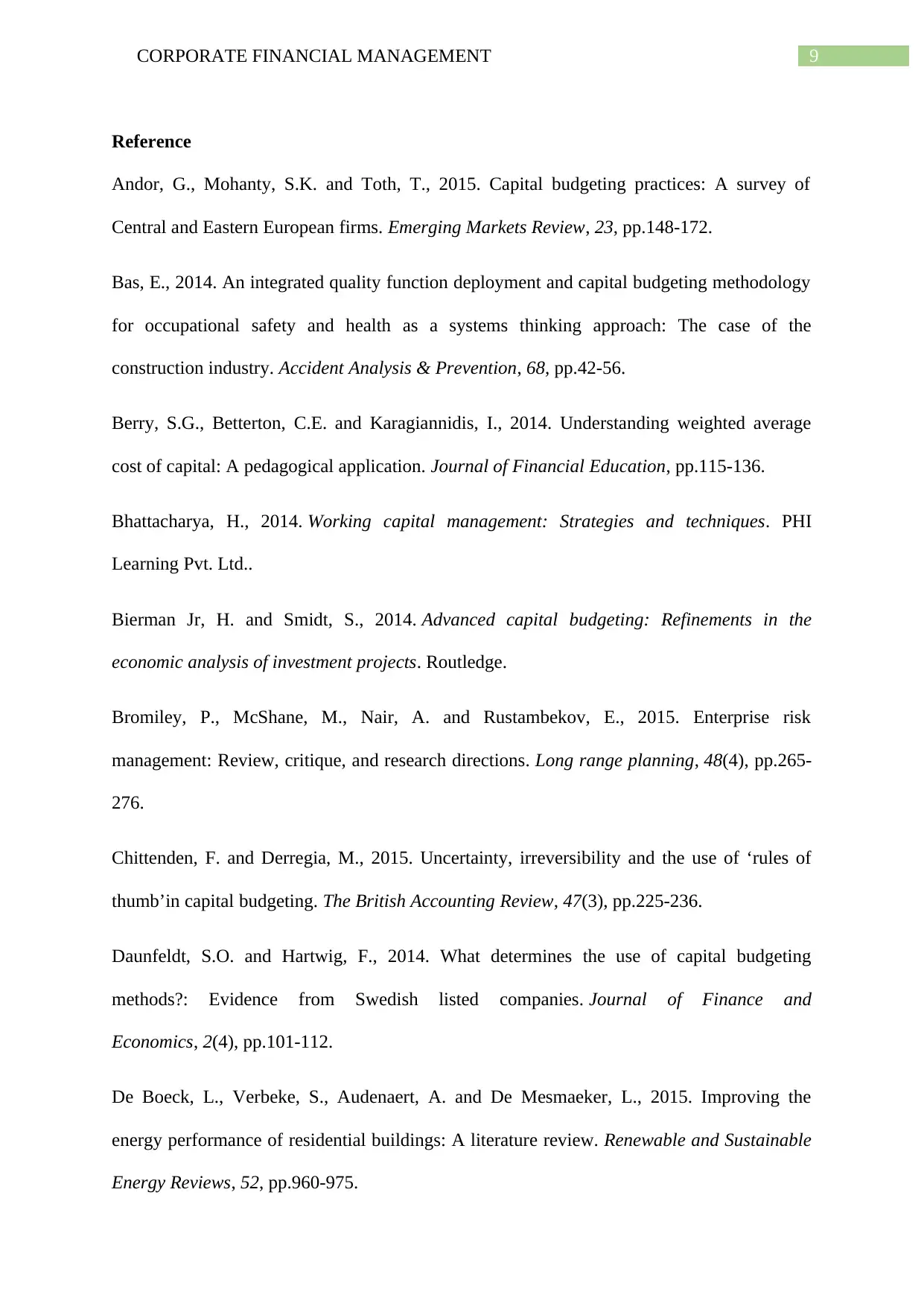
9CORPORATE FINANCIAL MANAGEMENT
Reference
Andor, G., Mohanty, S.K. and Toth, T., 2015. Capital budgeting practices: A survey of
Central and Eastern European firms. Emerging Markets Review, 23, pp.148-172.
Bas, E., 2014. An integrated quality function deployment and capital budgeting methodology
for occupational safety and health as a systems thinking approach: The case of the
construction industry. Accident Analysis & Prevention, 68, pp.42-56.
Berry, S.G., Betterton, C.E. and Karagiannidis, I., 2014. Understanding weighted average
cost of capital: A pedagogical application. Journal of Financial Education, pp.115-136.
Bhattacharya, H., 2014. Working capital management: Strategies and techniques. PHI
Learning Pvt. Ltd..
Bierman Jr, H. and Smidt, S., 2014. Advanced capital budgeting: Refinements in the
economic analysis of investment projects. Routledge.
Bromiley, P., McShane, M., Nair, A. and Rustambekov, E., 2015. Enterprise risk
management: Review, critique, and research directions. Long range planning, 48(4), pp.265-
276.
Chittenden, F. and Derregia, M., 2015. Uncertainty, irreversibility and the use of ‘rules of
thumb’in capital budgeting. The British Accounting Review, 47(3), pp.225-236.
Daunfeldt, S.O. and Hartwig, F., 2014. What determines the use of capital budgeting
methods?: Evidence from Swedish listed companies. Journal of Finance and
Economics, 2(4), pp.101-112.
De Boeck, L., Verbeke, S., Audenaert, A. and De Mesmaeker, L., 2015. Improving the
energy performance of residential buildings: A literature review. Renewable and Sustainable
Energy Reviews, 52, pp.960-975.
Reference
Andor, G., Mohanty, S.K. and Toth, T., 2015. Capital budgeting practices: A survey of
Central and Eastern European firms. Emerging Markets Review, 23, pp.148-172.
Bas, E., 2014. An integrated quality function deployment and capital budgeting methodology
for occupational safety and health as a systems thinking approach: The case of the
construction industry. Accident Analysis & Prevention, 68, pp.42-56.
Berry, S.G., Betterton, C.E. and Karagiannidis, I., 2014. Understanding weighted average
cost of capital: A pedagogical application. Journal of Financial Education, pp.115-136.
Bhattacharya, H., 2014. Working capital management: Strategies and techniques. PHI
Learning Pvt. Ltd..
Bierman Jr, H. and Smidt, S., 2014. Advanced capital budgeting: Refinements in the
economic analysis of investment projects. Routledge.
Bromiley, P., McShane, M., Nair, A. and Rustambekov, E., 2015. Enterprise risk
management: Review, critique, and research directions. Long range planning, 48(4), pp.265-
276.
Chittenden, F. and Derregia, M., 2015. Uncertainty, irreversibility and the use of ‘rules of
thumb’in capital budgeting. The British Accounting Review, 47(3), pp.225-236.
Daunfeldt, S.O. and Hartwig, F., 2014. What determines the use of capital budgeting
methods?: Evidence from Swedish listed companies. Journal of Finance and
Economics, 2(4), pp.101-112.
De Boeck, L., Verbeke, S., Audenaert, A. and De Mesmaeker, L., 2015. Improving the
energy performance of residential buildings: A literature review. Renewable and Sustainable
Energy Reviews, 52, pp.960-975.
Paraphrase This Document
Need a fresh take? Get an instant paraphrase of this document with our AI Paraphraser
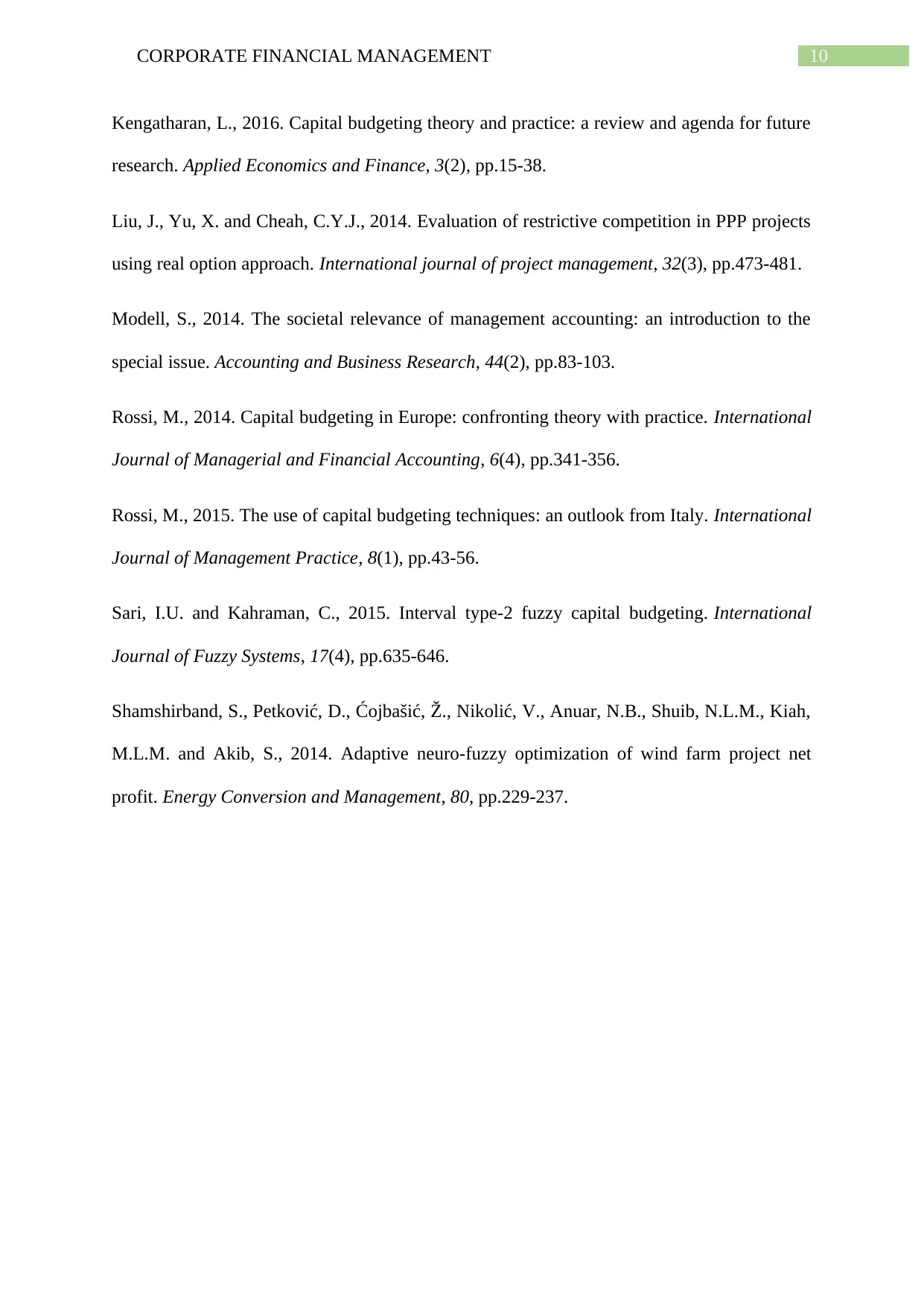
10CORPORATE FINANCIAL MANAGEMENT
Kengatharan, L., 2016. Capital budgeting theory and practice: a review and agenda for future
research. Applied Economics and Finance, 3(2), pp.15-38.
Liu, J., Yu, X. and Cheah, C.Y.J., 2014. Evaluation of restrictive competition in PPP projects
using real option approach. International journal of project management, 32(3), pp.473-481.
Modell, S., 2014. The societal relevance of management accounting: an introduction to the
special issue. Accounting and Business Research, 44(2), pp.83-103.
Rossi, M., 2014. Capital budgeting in Europe: confronting theory with practice. International
Journal of Managerial and Financial Accounting, 6(4), pp.341-356.
Rossi, M., 2015. The use of capital budgeting techniques: an outlook from Italy. International
Journal of Management Practice, 8(1), pp.43-56.
Sari, I.U. and Kahraman, C., 2015. Interval type-2 fuzzy capital budgeting. International
Journal of Fuzzy Systems, 17(4), pp.635-646.
Shamshirband, S., Petković, D., Ćojbašić, Ž., Nikolić, V., Anuar, N.B., Shuib, N.L.M., Kiah,
M.L.M. and Akib, S., 2014. Adaptive neuro-fuzzy optimization of wind farm project net
profit. Energy Conversion and Management, 80, pp.229-237.
Kengatharan, L., 2016. Capital budgeting theory and practice: a review and agenda for future
research. Applied Economics and Finance, 3(2), pp.15-38.
Liu, J., Yu, X. and Cheah, C.Y.J., 2014. Evaluation of restrictive competition in PPP projects
using real option approach. International journal of project management, 32(3), pp.473-481.
Modell, S., 2014. The societal relevance of management accounting: an introduction to the
special issue. Accounting and Business Research, 44(2), pp.83-103.
Rossi, M., 2014. Capital budgeting in Europe: confronting theory with practice. International
Journal of Managerial and Financial Accounting, 6(4), pp.341-356.
Rossi, M., 2015. The use of capital budgeting techniques: an outlook from Italy. International
Journal of Management Practice, 8(1), pp.43-56.
Sari, I.U. and Kahraman, C., 2015. Interval type-2 fuzzy capital budgeting. International
Journal of Fuzzy Systems, 17(4), pp.635-646.
Shamshirband, S., Petković, D., Ćojbašić, Ž., Nikolić, V., Anuar, N.B., Shuib, N.L.M., Kiah,
M.L.M. and Akib, S., 2014. Adaptive neuro-fuzzy optimization of wind farm project net
profit. Energy Conversion and Management, 80, pp.229-237.
1 out of 11
Related Documents
Your All-in-One AI-Powered Toolkit for Academic Success.
+13062052269
info@desklib.com
Available 24*7 on WhatsApp / Email
![[object Object]](/_next/static/media/star-bottom.7253800d.svg)
Unlock your academic potential
Copyright © 2020–2025 A2Z Services. All Rights Reserved. Developed and managed by ZUCOL.




